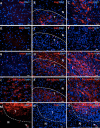A tree shrew glioblastoma model recapitulates features of human glioblastoma
- PMID: 28199986
- PMCID: PMC5392295
- DOI: 10.18632/oncotarget.15225
A tree shrew glioblastoma model recapitulates features of human glioblastoma
Abstract
Tupaia belangeri (tree shrew), an animal species whose genome has significantly higher similarity to primates than rodents, has been used in biomedical research. To generate animal models that reproduce the human tumors more faithfully than rodents, we present the first report of a cancer model mimicking human tumor genetics in tree shrew. By engineering a lentiviral system for the transduction of mutant H-Ras and a shRNA against tree shrew p53, we successfully generated malignant glioma in tree shrew. The tree shrew glioma exhibited aggressive behavior and a relatively short latency, and markedly reduced animal survival. Remarkably, the biological features of human high-grade glioma (necrosis, microvascular proliferation, pseudopalisading) were all present in tree shrew glioma. Furthermore, genetic analysis of tree shrew glioma revealed that the tumors were clustered within the mesenchymal subgroup of human glioblastoma multiforme. Compared with the corresponding mouse glioma, tree shrew gliomas were markedly more similar to human glioblastoma at gene expression profile. The tree shrew glioma model provides colleagues working in the field of gliomas and cancer in general with a more accurate animal model.
Keywords: P53; animal model; glioblastoma; tree shrew.
Conflict of interest statement
The authors declare no conflicts of interest.
Figures






References
-
- Stupp R, Hegi ME, Mason WP, van den Bent MJ, Taphoorn MJ, Janzer RC, Ludwin SK, Allgeier A, Fisher B, Belanger K, Hau P, Brandes AA, Gijtenbeek J, et al. Effects of radiotherapy with concomitant and adjuvant temozolomide versus radiotherapy alone on survival in glioblastoma in a randomised phase III study: 5-year analysis of the EORTC-NCIC trial. Lancet Oncol. 2009;10:459–66. - PubMed
MeSH terms
Substances
LinkOut - more resources
Full Text Sources
Other Literature Sources
Research Materials
Miscellaneous

